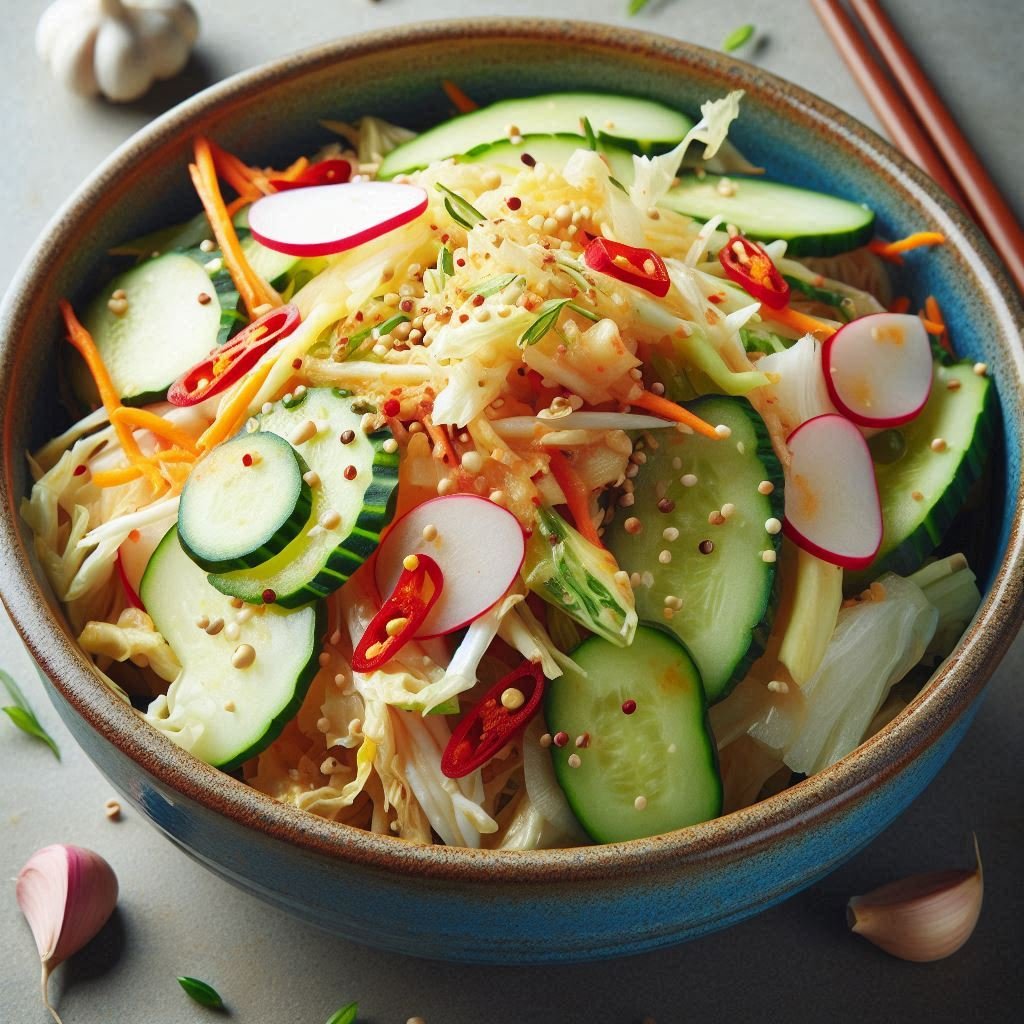Kimchi
Kimchi is a traditional Korean dish made from fermented vegetables, most commonly napa cabbage and Korean radishes, with a variety of seasonings, including gochugaru (Korean chili powder), garlic, ginger, and scallions. It is known for its spicy, tangy flavor and is often enjoyed as a side dish or used as an ingredient in various Korean recipes. The fermentation process not only gives kimchi its distinctive taste but also provides health benefits due to the probiotics produced during fermentation.
Kimchi is a traditional Korean dish made from fermented vegetables, most commonly napa cabbage and Korean radishes, with a variety of seasonings, including gochugaru (Korean chili powder), garlic, ginger, and scallions. It is known for its spicy, tangy flavor and is often enjoyed as a side dish or used as an ingredient in various Korean recipes. The fermentation process not only gives kimchi its distinctive taste but also provides health benefits due to the probiotics produced during fermentation.
Kimchi is a traditional Korean dish made from fermented vegetables, most commonly napa cabbage and Korean radishes, with a variety of seasonings, including gochugaru (Korean chili powder), garlic, ginger, and scallions. It is known for its spicy, tangy flavor and is often enjoyed as a side dish or used as an ingredient in various Korean recipes. The fermentation process not only gives kimchi its distinctive taste but also provides health benefits due to the probiotics produced during fermentation.
Here's a simple recipe for making traditional kimchi:
Ingredients:
1 medium napa cabbage (about 2 pounds)
1/4 cup sea salt or kosher salt
1 tablespoon sugar
5-6 cups water
4-5 radishes, julienned
1 bunch of green onions, chopped
1 carrot, julienned (optional)
For the kimchi paste:
1/2 cup Korean chili powder (gochugaru)
1/4 cup fish sauce
2 tablespoons minced garlic
1 tablespoon minced ginger
1 tablespoon sugar
2-3 tablespoons water (to adjust consistency)
Instructions:
1. Prepare the Cabbage:
Cut the cabbage into quarters lengthwise, then cut each quarter into 2-inch wide strips.
Place the cabbage in a large bowl and sprinkle with salt, making sure to get the salt between the layers.
Let it sit for 1-2 hours, turning occasionally to ensure even salting. The cabbage will soften and release water.
Rinse the cabbage thoroughly under cold water to remove excess salt, then drain and squeeze out any excess water.
2. Prepare the Vegetables:
Julienne the radishes and carrots (if using).
Chop the green onions.
3. Make the Kimchi Paste:
In a small bowl, combine the chili powder, fish sauce, minced garlic, minced ginger, sugar, and a few tablespoons of water to make a thick paste. Adjust the water to get a spreadable consistency.
4. Mix the Kimchi:
In a large bowl, combine the drained cabbage, radishes, carrots, and green onions.
Add the kimchi paste and mix everything thoroughly. It's best to use your hands (wearing gloves) to ensure all the vegetables are well coated with the paste.
5. Ferment the Kimchi:
Pack the kimchi into a clean, airtight container or jar, pressing down to remove any air bubbles.
Leave some space at the top of the jar as the kimchi may expand during fermentation.
Seal the jar and leave it at room temperature for 1-2 days to start the fermentation process.
After 1-2 days, transfer the jar to the refrigerator. The kimchi will continue to ferment and develop its flavor over the next 1-2 weeks.
Tips:
Taste the kimchi after a few days and adjust the fermentation time to your liking. The longer it ferments, the tangier and more pungent it will become.
Use clean utensils when handling kimchi to avoid introducing any contaminants.
Enjoy your homemade kimchi as a side dish, in soups, or as a flavorful addition to your meals!
4o


